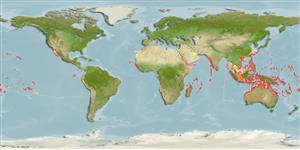Environment: milieu / climate zone / depth range / distribution range
Écologie
marin récifal; profondeur 0 - 50 m (Ref. 7348). Tropical; 30°N - 30°S
Indo-Pacific: East Africa eastward through northern Australia to Hawaiian, Marquesas and Tuamotu islands, north to southern Japan.
Length at first maturity / Taille / Poids / Âge
Maturity: Lm 14.0 range ? - ? cm
Max length : 30.0 cm TL mâle / non sexé; (Ref. 4420); common length : 15.0 cm TL mâle / non sexé; (Ref. 5450)
Épines dorsales (Total) : 3; Rayons mous dorsaux (Total) : 23 - 26; Épines anales: 0; Rayons mous anaux: 21 - 23.
Commonly found in subtidal reef flats and shallow protected lagoons, Ref. 48637. Benthopelagic (Ref. 58302). Juveniles secretive with rubble patches, adults swim about openly but are usually shy (Ref. 48637). Territorial. Feed on algae, detritus, mollusks, crustaceans, worms, sea urchins, fishes, corals, tunicates, forams, and eggs (Ref. 3921). Oviparous (Ref. 205). Sleep on its side; makes a whirring noise when alarmed (Ref. 4420). Also caught with drive-in nets and is considered a popular aquarium fish (Ref. 9770).
Life cycle and mating behavior
Maturities | Reproduction | Spawnings | Egg(s) | Fecundities | Larves
Distinct pairing (Ref. 205). Mating system may be a mixture of polygyny, monogamy, and potential promiscuity in solitary females but the primary mating system considered for this species is polygyny (Ref. 116439). Females are territorial, solely tending and guarding the eggs (Ref. 116451). Males exhibit polygyny (Ref. 116451).
Myers, R.F., 1991. Micronesian reef fishes. Second Ed. Coral Graphics, Barrigada, Guam. 298 p. (Ref. 1602)
Statut dans la liste rouge de l'IUCN (Ref. 130435)
Menace pour l'homme
Reports of ciguatera poisoning (Ref. 130160)
Utilisations par l'homme
Pêcheries: intérêt commercial mineur; Aquarium: Commercial
Outils
Articles particuliers
Télécharger en XML
Sources Internet
Estimates based on models
Preferred temperature (Ref.
123201): 24.5 - 29, mean 27.7 °C (based on 1010 cells).
Phylogenetic diversity index (Ref.
82804): PD
50 = 0.5078 [Uniqueness, from 0.5 = low to 2.0 = high].
Bayesian length-weight: a=0.01905 (0.01109 - 0.03275), b=2.93 (2.78 - 3.08), in cm total length, based on LWR estimates for this species & (Sub)family-body (Ref.
93245).
Niveau trophique (Ref.
69278): 3.2 ±0.1 se; based on diet studies.
Generation time: 2.7 ( na - na) years. Estimated as median ln(3)/K based on 1
growth studies.
Résilience (Ref.
120179): Haut, temps minimum de doublement de population inférieur à 15 mois (K=0.4).
Fishing Vulnerability (Ref.
59153): Low to moderate vulnerability (30 of 100).
Nutrients (Ref.
124155): Calcium = 46.5 [19.5, 110.3] mg/100g; Iron = 0.619 [0.323, 1.399] mg/100g; Protein = 18.3 [16.2, 20.5] %; Omega3 = 0.115 [0.058, 0.223] g/100g; Selenium = 34.7 [18.2, 72.2] μg/100g; VitaminA = 54.6 [15.8, 190.6] μg/100g; Zinc = 1.12 [0.76, 1.64] mg/100g (wet weight);
